from May. 20, 1865
John Wilkes Booth "Buried at Sea"
-
Full Title
John Wilkes Booth "Buried at Sea" - Frank Leslie's Illustrated Newspaper Drawing
-
Description
In the May 20th, 1865 edition of Frank Leslie's Illustrated Weekly newspaper, this image was printed inaccurately depicting the burial of President Lincoln's assassin, actor John Wilkes Booth. The federal government was worried what the public would do if they buried the body, so they staged a burial at sea and then secretly buried the assassin in an unmarked location. In 1869 they released the body to Booth's family and he was reburied in their family plot in Baltimore, Maryland. Frank Leslie's Illustrated Weekly was a literary and news publication founded in 1855 which ran until 1922. It was one of several started by publisher and illustrator Frank Leslie. Leslie was a British engraver who came to the United States in 1848. The Illustrated Weekly followed a tested and proven formula of carefully combining elements of war, politics, art, science, travel and exploration, literature and the fine arts in each issue, enhanced with between 16 and 32 illustrations. By 1897 its circulation had grown to an estimated 65,000 copies.
-
Source
The Lincoln Financial Foundation Collection
-
Rights
To request rights and permissions to use Lincoln Financial Foundation Collection images in research or publications, please download our image rights permission form: https://www.lincolncollection.org/access/image-rights-permissions/.
-
Tags
-
Cite this Item
Frank Leslie. "John Wilkes Booth "Buried at Sea" - Frank Leslie's Illustrated Newspaper Drawing". Frank Leslie . Remembering Lincoln. Web. Accessed December 13, 2025. https://rememberinglincoln.fords.org/node/1110
-
Creator
Frank Leslie
-
Publisher
Frank Leslie
-
Date
May 20, 1865
from May. 20, 1865
John Wilkes Booth "Buried at Sea" - Frank Leslie's Illustrated Newspaper Drawing
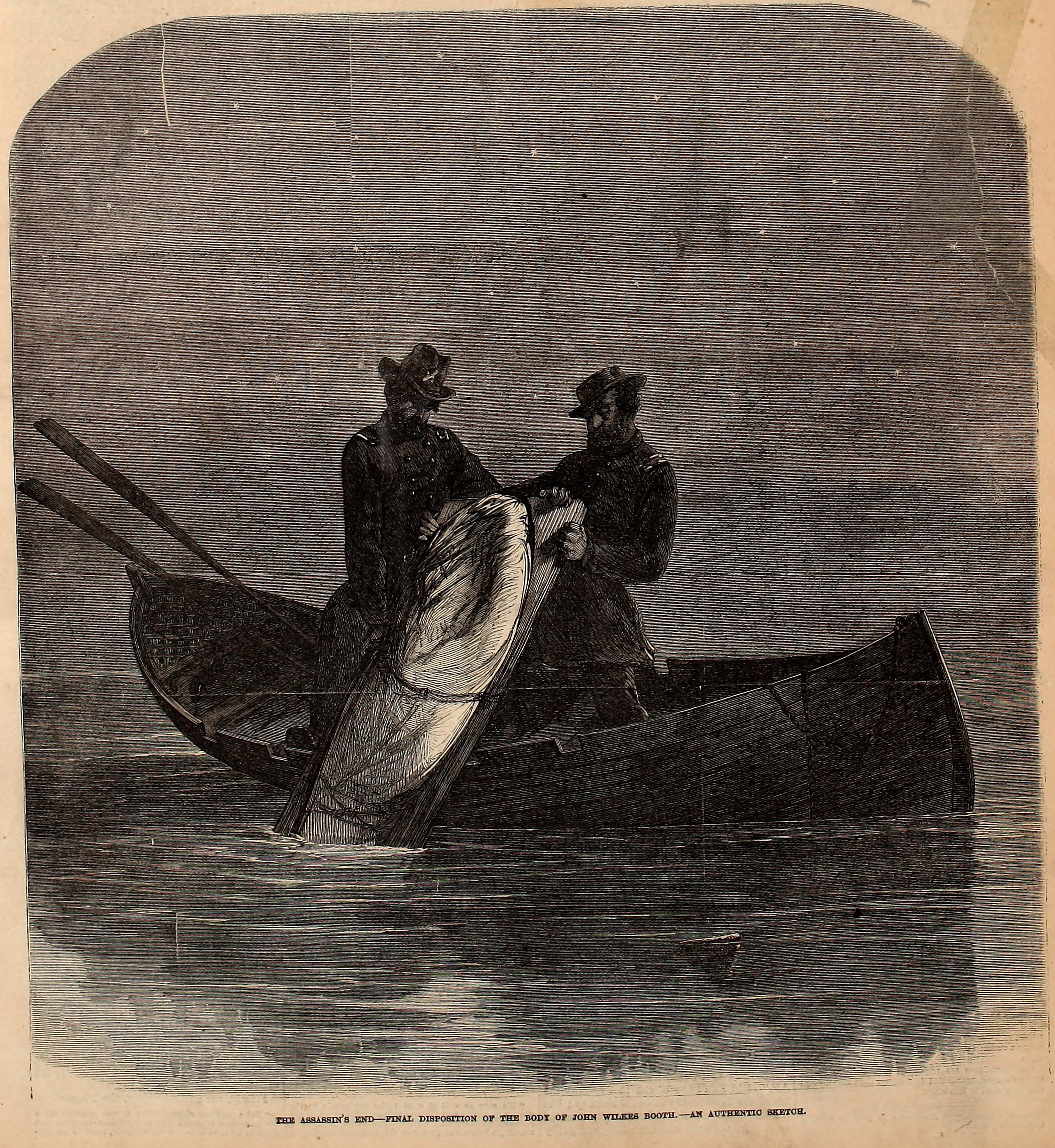
-
Description
In the May 20th, 1865 edition of Frank Leslie's Illustrated Weekly newspaper, this image was printed inaccurately depicting the burial of President Lincoln's assassin, actor John Wilkes Booth. The federal government was worried what the public would do if they buried the body, so they staged a burial at sea and then secretly buried the assassin in an unmarked location. In 1869 they released the body to Booth's family and he was reburied in their family plot in Baltimore, Maryland. Frank Leslie's Illustrated Weekly was a literary and news publication founded in 1855 which ran until 1922. It was one of several started by publisher and illustrator Frank Leslie. Leslie was a British engraver who came to the United States in 1848. The Illustrated Weekly followed a tested and proven formula of carefully combining elements of war, politics, art, science, travel and exploration, literature and the fine arts in each issue, enhanced with between 16 and 32 illustrations. By 1897 its circulation had grown to an estimated 65,000 copies.
-
Source
The Lincoln Financial Foundation Collection
-
Rights
To request rights and permissions to use Lincoln Financial Foundation Collection images in research or publications, please download our image rights permission form: https://www.lincolncollection.org/access/image-rights-permissions/.
-
Creator
Frank Leslie
-
Publisher
Frank Leslie
-
Date
May 20, 1865
from May. 13, 1865
Abraham Lincoln's Coffin
-
Full Title
Abraham Lincoln's Coffin - Frank Leslie's Illustrated Newspaper Drawing
-
Description
In the May 13th, 1865 edition of Frank Leslie's Illustrated Weekly newspaper, this image was printed next to an article about President Lincoln's funeral. The illustrated literary and news publication was founded in 1855 and continued until 1922. It was one of several started by publisher and illustrator Frank Leslie. Leslie was a British engraver who came to the United States in 1848. The Illustrated Weekly followed a tested and proven formula of carefully combining elements of war, politics, art, science, travel and exploration, literature and the fine arts in each issue, enhanced with between 16 and 32 illustrations. By 1897 its circulation had grown to an estimated 65,000 copies.
-
Source
The Lincoln Financial Foundation Collection
-
Rights
To request rights and permissions to use Lincoln Financial Foundation Collection images in research or publications, please download our image rights permission form: https://www.lincolncollection.org/access/image-rights-permissions/.
-
Tags
-
Cite this Item
Frank Leslie. "Abraham Lincoln's Coffin - Frank Leslie's Illustrated Newspaper Drawing". Frank Leslie. Remembering Lincoln. Web. Accessed December 13, 2025. https://rememberinglincoln.fords.org/node/1109
-
Creator
Frank Leslie
-
Publisher
Frank Leslie
-
Date
May 13, 1865
from May. 13, 1865
Abraham Lincoln's Coffin - Frank Leslie's Illustrated Newspaper Drawing
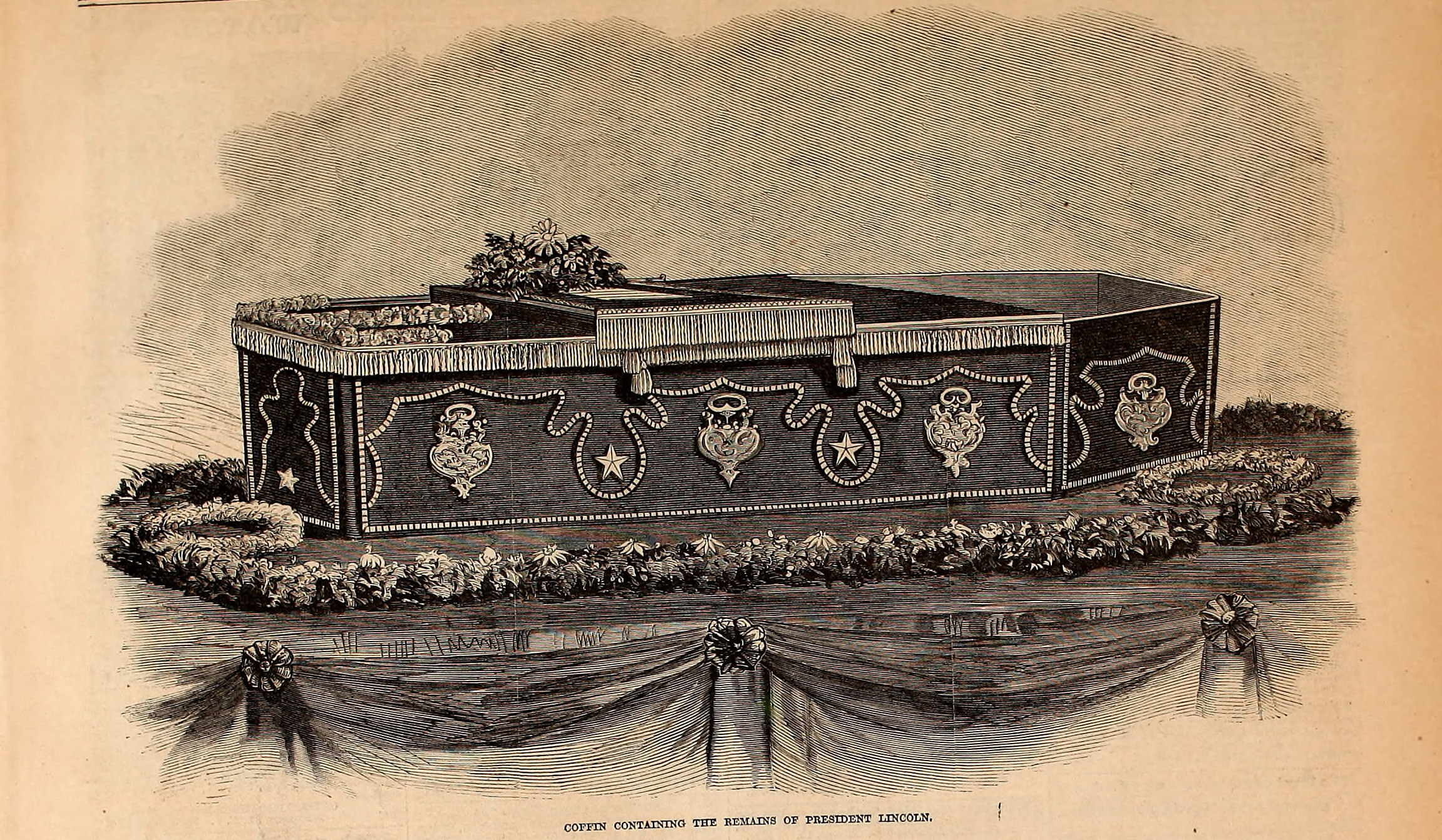
-
Description
In the May 13th, 1865 edition of Frank Leslie's Illustrated Weekly newspaper, this image was printed next to an article about President Lincoln's funeral. The illustrated literary and news publication was founded in 1855 and continued until 1922. It was one of several started by publisher and illustrator Frank Leslie. Leslie was a British engraver who came to the United States in 1848. The Illustrated Weekly followed a tested and proven formula of carefully combining elements of war, politics, art, science, travel and exploration, literature and the fine arts in each issue, enhanced with between 16 and 32 illustrations. By 1897 its circulation had grown to an estimated 65,000 copies.
-
Source
The Lincoln Financial Foundation Collection
-
Rights
To request rights and permissions to use Lincoln Financial Foundation Collection images in research or publications, please download our image rights permission form: https://www.lincolncollection.org/access/image-rights-permissions/.
-
Creator
Frank Leslie
-
Publisher
Frank Leslie
-
Date
May 13, 1865
from May. 1, 1865
Letter to Mary Todd Lincoln from Queen Victoria
-
Full Title
Letter to Mary Todd Lincoln from Queen Victoria
-
Description
Manuscript transcription of a letter from Queen Victoria to Mrs. Abraham Lincoln, written in purple ink on white woven paper. Queen Victoria, the British monarch, wrote to Mary Lincoln after learning about the assassination of Abraham Lincoln. The two women had never met, but Queen Victoria wanted to convey her sympathies to Mrs. Lincoln because she also lost her husband in 1861 and went into intense mourning.
-
Transcription
Copy of a letter from Queen Victoria to Mrs. President Lincoln Osborne, April. 1865
Thought a stranger to you, cannot remain silent w[?] so terrible a calamity has fallen upon you and your country; and must personally express my deep and heartfelt sympathy wi[?] you under shocking circumstances of your present— dreadful misfortune. No one can better appreciate, than I can, who am myself utterly broken hearted by the loss of my own beloved husband, who was the light of my life, my stay, my all, —what your own sufferings must be, and I earnestly pray that you may be supported by Him, to whom alone the sorely stricken can look for comfort in their hour of heavy afflication.
With the renewed expression of true sympathy, I remain, dear Madam, Your sincere friend, Victoria -
Source
Library of Congress
-
Rights
This item is in the public domain and may be reproduced and used for any purpose, including research, teaching, private study, publication, broadcast or commercial use, with proper citation and attribution.
-
Tags
-
Cite this Item
Queen Victoria. "Letter to Mary Todd Lincoln from Queen Victoria". Remembering Lincoln. Web. Accessed December 13, 2025. https://rememberinglincoln.fords.org/node/1108
-
Creator
Queen Victoria
-
Date
1865
-
Dimensions
21 x 11 cm
from May. 1, 1865
Letter to Mary Todd Lincoln from Queen Victoria
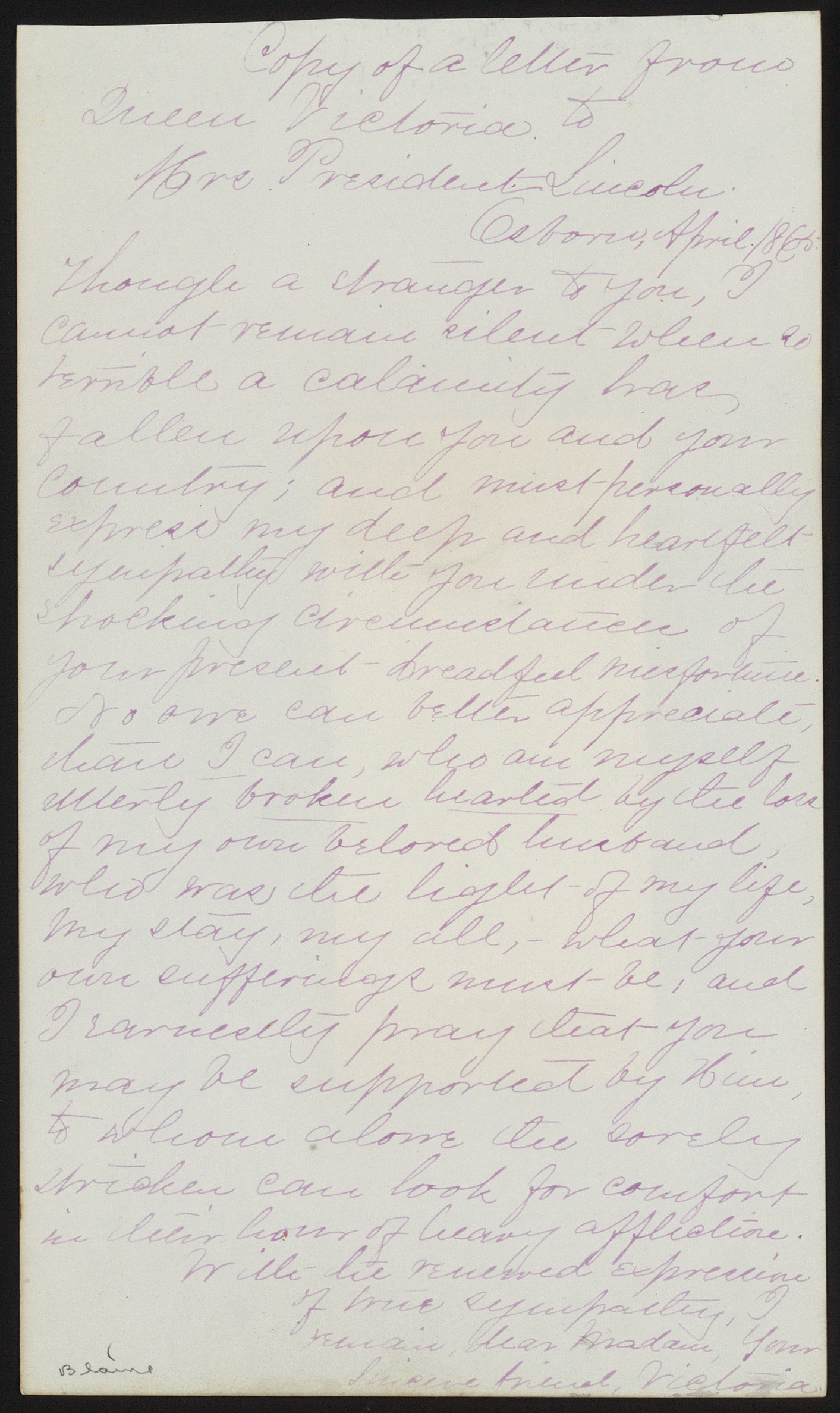
-
Description
Manuscript transcription of a letter from Queen Victoria to Mrs. Abraham Lincoln, written in purple ink on white woven paper. Queen Victoria, the British monarch, wrote to Mary Lincoln after learning about the assassination of Abraham Lincoln. The two women had never met, but Queen Victoria wanted to convey her sympathies to Mrs. Lincoln because she also lost her husband in 1861 and went into intense mourning.
-
Source
Library of Congress
-
Rights
This item is in the public domain and may be reproduced and used for any purpose, including research, teaching, private study, publication, broadcast or commercial use, with proper citation and attribution.
-
Creator
Queen Victoria
-
Date
May 1, 1865
-
Dimensions
21 x 11 cm
from Apr. 14, 1865
Horatio Nelson Taft Diary, April 6-14, 1865
-
Full Title
Horatio Nelson Taft Diary, April 6-14, 1865
-
Description
This excerpt from the diary of Horatio Nelson Taft is an insight into some of the first reactions of citizens of the Union to the death of President Lincoln. Taft, who was a patent clerk, laments Lincoln's teach and denounces the assassination as assassination at it's worst. In the entry just prior to the excerpt describing Lincoln's death, Taft described the return of Lincoln to Washington after a Union victory.
-
Transcription
April 6th 1865
Mr Lincoln has been in Richmond. Near half of the City has been destroyed by fire by the
Rebels themselves as they evacuated it. Large numbers of prisoners have been captured
by Sheridan, Genl Ewell and his Corps, some seven thousand.
April 9, 1865
Genl Lee has surrendered to Genl Grant with his whole Army!! Mr Lincoln has returned to
Washington as in fine Spirits at the prospect of a speedy peace. It is thought that Johnson
and the other rebel Genls will give up now that Lee has surrendered.
April 14th ½ past 10 o'clock P.M.
O, fatal day. O, noble Victim.
Treason has done its worst.
The President has been Assassinated.
It has just been announced at my door
that he was shot a half hour ago at Fords Theatre.
Is it possible?
I have just come from near the scene,
it is too True. 11, o'clock P.M. -
Source
memory.loc.gov
-
Rights
This item is in the public domain and may be reproduced and used for any purpose, including research, teaching, private study, publication, broadcast or commercial use, with proper citation and attribution.
-
Tags
-
Cite this Item
Horatio Nelson Taft. "Horatio Nelson Taft Diary, April 6-14, 1865". Remembering Lincoln. Web. Accessed December 13, 2025. https://rememberinglincoln.fords.org/node/1107
from Apr. 14, 1865
Horatio Nelson Taft Diary, April 6-14, 1865
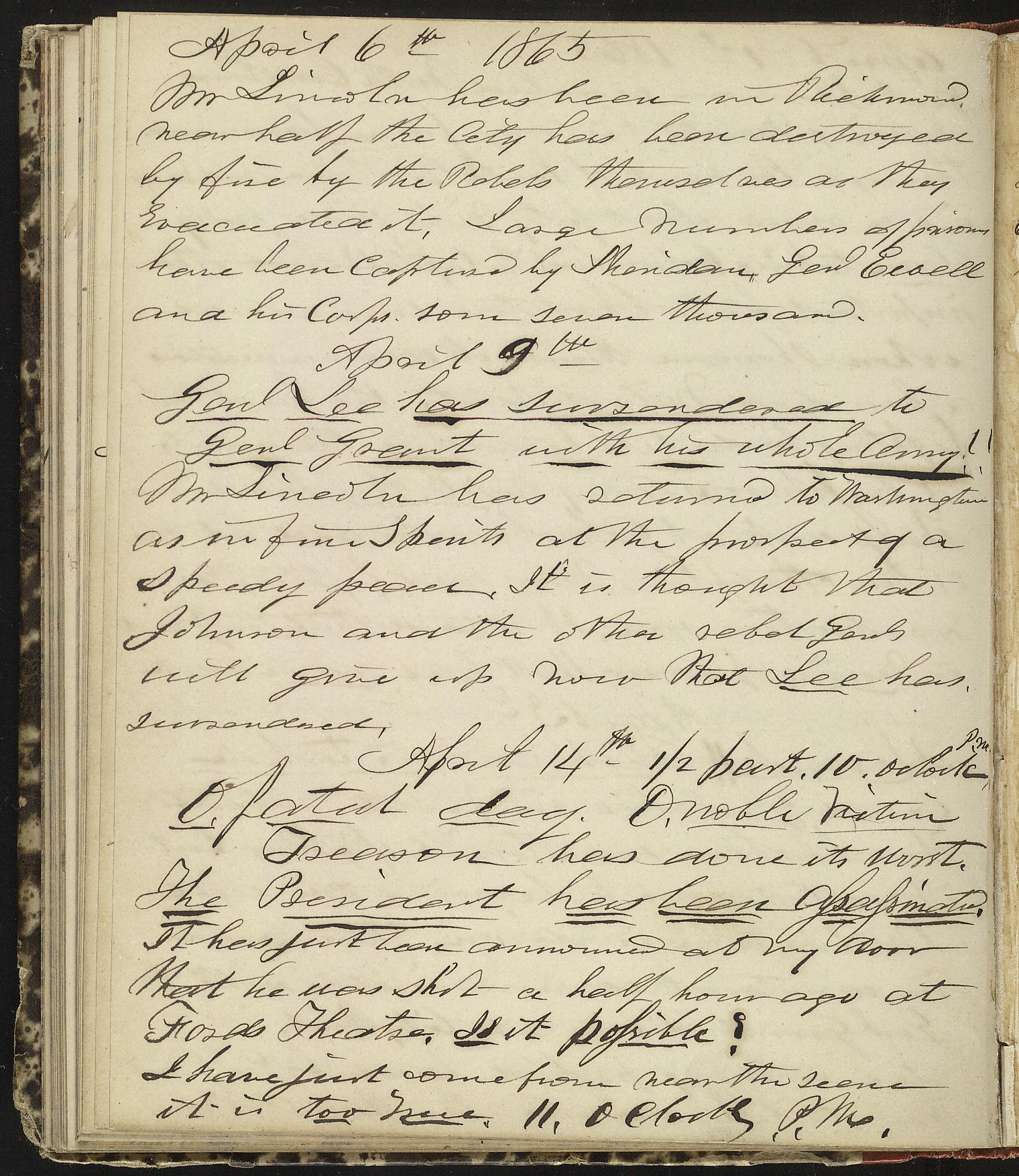
-
Description
This excerpt from the diary of Horatio Nelson Taft is an insight into some of the first reactions of citizens of the Union to the death of President Lincoln. Taft, who was a patent clerk, laments Lincoln's teach and denounces the assassination as assassination at it's worst. In the entry just prior to the excerpt describing Lincoln's death, Taft described the return of Lincoln to Washington after a Union victory.
-
Source
memory.loc.gov
-
Rights
This item is in the public domain and may be reproduced and used for any purpose, including research, teaching, private study, publication, broadcast or commercial use, with proper citation and attribution.
-
Creator
Horatio Nelson Taft
-
Date
April 14, 1865
-
Material
bound paper with script in ink and type
from Apr. 28, 1865
John Wilkes Booth, El Asesino Del Presidente Lincoln
-
Full Title
John Wilkes Booth, El Asesino Del Presidente Lincoln: Despatchos Telegraficos
-
Description
In this article from the California-based periodical, El Voz del Nuevo Mundo (commonly referred to as El Nuevo Mundo,) the details of Lincoln's assassination and of John Wilkes Boothe's ultimate demise.
-
Source
infoweb.newsbank.com
-
Rights
N/A
-
Tags
-
Cite this Item
El Voz del Nuevo Mundo. "John Wilkes Booth, El Asesino Del Presidente Lincoln: Despatchos Telegraficos". El Voz del Nuevo Mundo. Remembering Lincoln. Web. Accessed December 13, 2025. https://rememberinglincoln.fords.org/node/1106
from Apr. 28, 1865
John Wilkes Booth, El Asesino Del Presidente Lincoln: Despatchos Telegraficos

-
Description
In this article from the California-based periodical, El Voz del Nuevo Mundo (commonly referred to as El Nuevo Mundo,) the details of Lincoln's assassination and of John Wilkes Boothe's ultimate demise.
-
Source
infoweb.newsbank.com
-
Rights
N/A
-
Creator
El Voz del Nuevo Mundo
-
Publisher
El Voz del Nuevo Mundo
-
Date
April 28, 1865
-
Material
newspaper
from Aug. 20, 1867
Memorial of President Lincoln in London
-
Full Title
Memorial of President Lincoln in London
-
Description
This article from the San Antonio Express cites an article from the London Star, purporting that a memorial was being built in London to honor of President Lincoln and the abolition of slavery in the United States.
-
Transcription
MEMORIAL OF PRESIDENT LINCOLN in LONDON.—
The London Star says. There are no building in London a church, a public hall and a school-room attached, intended to be a memorial of the abolition of slavery in America, and of the public services of the late President Lincoln. The work is under the superintendence of Dr. F. Tompkins, D. C. L. who who has spent some time in America. The Rev. C.W. Dension, the American agent, has not presented this object in Paris, as a meeting was held on the subject at the Salle Evangeline, in the exhibition on Thursday. J. P. Reynolds, one of the commissioners for the State of Illinois, presided, and the Rev. T. B. Hart, the minister of the English Chapel, Rue Royale, officiated as secretary. Statements with reference to the memorial were made by the Rev. Mr. Denison, the Hon. Mr. Usher, Dr. Smith of Boston, Dr. Freeze of New Jersey, and others, and a resolution commenting it was passed by the meeting.
[Transcription by: Ricarda H., Dr. Susan Corbesero’s Class, Ellis School, Pittsburgh, Pennsylvania] -
Source
infoweb.newsbank.com
-
Rights
N/A
-
Tags
-
Cite this Item
San Antonio Express. "Memorial of President Lincoln in London". San Antonio Express. Remembering Lincoln. Web. Accessed December 13, 2025. https://rememberinglincoln.fords.org/node/1105
from Aug. 20, 1867
Memorial of President Lincoln in London
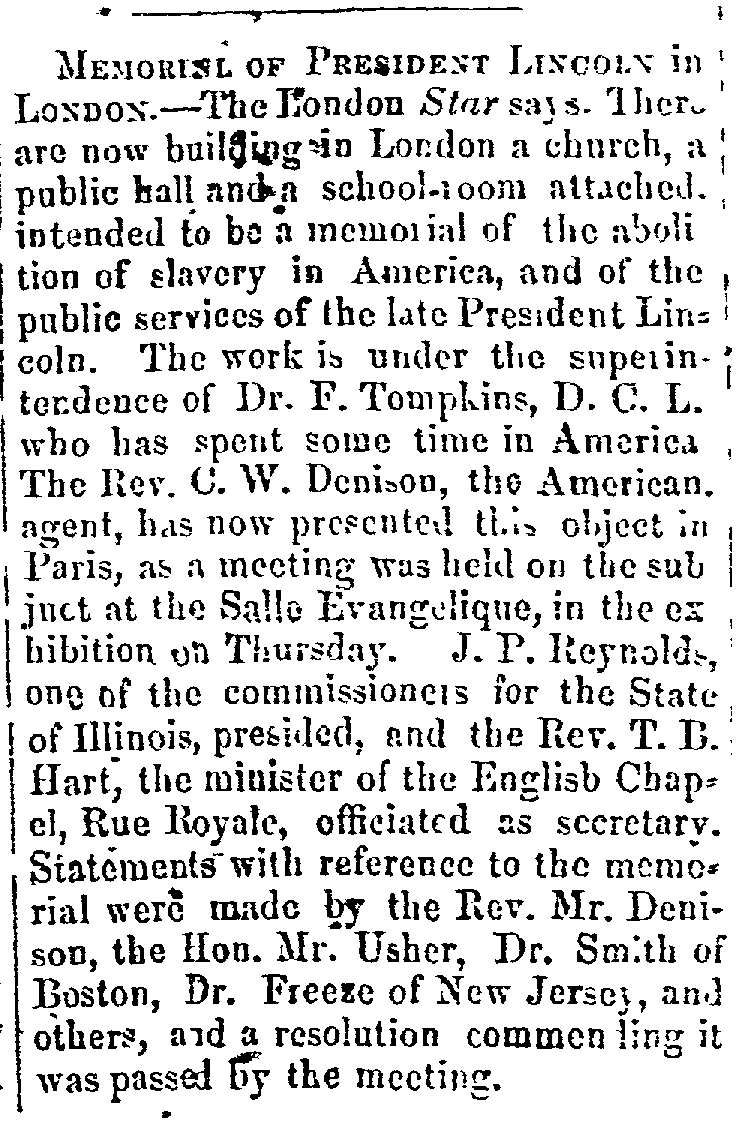
-
Description
This article from the San Antonio Express cites an article from the London Star, purporting that a memorial was being built in London to honor of President Lincoln and the abolition of slavery in the United States.
-
Source
infoweb.newsbank.com
-
Rights
N/A
-
Creator
San Antonio Express
-
Publisher
San Antonio Express
-
Date
August 20, 1867
-
Material
newspaper
from May. 13, 1865
President Lincoln's funeral
-
Full Title
President Lincoln's funeral. [Harper's Weekly illustration.]
-
Description
This illustration from Harper's Weekly depicts the funeral procession of Abraham Lincoln in an issue published on May 13, 1865. Guided by Union Soldiers on all sides, Lincoln's body is processed through the crowded streets of New York City as onlookers gather to see their beloved President. In the center of the illustration, a balcony is adorned with a banner that reads "WITH MALICE TOWARD NONE, WITH CHARITY FOR ALL," referring to Lincoln's Second Inaugural Address on March 4, 1865.
-
Source
Library of Congress, Rare Book and Special Collections Division, Alfred Whital Stern Collection of Lincolniana.
-
Rights
This item is in the public domain and may be reproduced and used for any purpose, including research, teaching, private study, publication, broadcast or commercial use, with proper citation and attribution.
-
Tags
-
Cite this Item
Mathew Brady. "President Lincoln's funeral. [Harper's Weekly illustration.]". Harper's Weekly. Remembering Lincoln. Web. Accessed December 13, 2025. https://rememberinglincoln.fords.org/node/1104
from May. 13, 1865
President Lincoln's funeral. [Harper's Weekly illustration.]
![President Lincoln's funeral. [Harper's Weekly illustration.]](https://rememberinglincoln.fords.org/sites/default/files/001r%5B1%5D.png)
-
Description
This illustration from Harper's Weekly depicts the funeral procession of Abraham Lincoln in an issue published on May 13, 1865. Guided by Union Soldiers on all sides, Lincoln's body is processed through the crowded streets of New York City as onlookers gather to see their beloved President. In the center of the illustration, a balcony is adorned with a banner that reads "WITH MALICE TOWARD NONE, WITH CHARITY FOR ALL," referring to Lincoln's Second Inaugural Address on March 4, 1865.
-
Source
Library of Congress, Rare Book and Special Collections Division, Alfred Whital Stern Collection of Lincolniana.
-
Rights
This item is in the public domain and may be reproduced and used for any purpose, including research, teaching, private study, publication, broadcast or commercial use, with proper citation and attribution.
-
Creator
Mathew Brady
-
Publisher
Harper's Weekly
-
Date
May 13, 1865
-
Material
newspaper
-
Dimensions
40.1 x 55.7 cm.
from Mar. 2, 1867
"LINCOLN"
-
Full Title
"LINCOLN": San Antonio Express
-
Description
This article, published by the San Antonio Express on March 2, 1867, contains an interview with William Herndon's law partner. Herndon spoke of Lincoln's romantic ventures in his earlier years. Following the interview, a beautiful description of the grave of Lincoln is provided.
-
Transcription
LINCOLN
A special correspondent of the New York Tribune, writing from Springfield, Ill., relates the following episode in the life of Mr. Lincoln. Mr. Herndon was Mr. Lincoln's law partner. The correspondent says:
"The tenderness of Mr. Lincoln nature romance in early manhood, and as of this Mr. Herndon had spoken in public, I asked particularly about it.
At Sangamon, Illinois, a pretty and high-spirited girl, without fortune, made havoc in many hearts and Mr. Lincoln constituted one of three earnest suitors who wanted her in marriage. She preferred the address of a young merchant of the town, and gave the other two their conge. Her affianced soon afterwards went East to buy goods, but as he returned was taken with brain fever in some wayside town, and lay raving for three months, unknown by name or residence to his entertainers. A rumor started that he had run away to avoid marrying his lady, and waiting some time in vain to hear from him, she received anew the attentions of Mr. Lincoln. About the time when they passed from courtesy to tenderness, and marriage between them was more than hinted at, the sick man returned like a ghost, gauged the condition of affairs, and upbraided the lady with fickleness. She had a delicate sense of honor, and felt keenly the shame of having seemed to trifle with two gentlemen at once; this preyed upon her mind til her body, not very strong, suffered by sympathy, and Mr. Herndon has oral and written testimony that the girl died out of regret at the equivocal position she had unwillingly assumed. The names of all the parties he has given me, but I do not care to print them."
The same writer gives the following beautifully description of the spot where lies all that is mortal of the lamented savior of our country:
"I know of no better illustration of the difference between the real life and the renown of Mr. Lincoln than you get by visiting his grave. A horse railroad, two miles long, leads to it, in the cemetery of Oak Ridge. Behind you is his real life, Springfield, a Western market town, set upon the monotonous prairie, half the year noisy with the chatter of politicians, plethoric with lawyers, for all of whom there is less than enough to do, and savoring much of the frost and the frontier; a pretty prairie city, but capitalized so that what the State has not done for the town, and the people expected it to do, make an unfinished desultoryness. – All at once, as you approach the Sangamon river, the scene changes. Stalwart young oaks of natural growth become plentiful. The landscape is plowed with leafy ravines. Bold knowls start up. – A creek goes plashing around the abrupt hills. Shadow, murmur, and surprise succeed the level life of the city. And among all these mysteries, itself the great mystery of our age, the vault of the President caps a hill, a temporary edifice of brick, and the great drive of one of the handsomest cemeteries in the Union winds with the winding brook beneath it:
"The last
As 'twere the cape of a long ridge of hills,"
and all the white tombs martial it; buttonwood, maple and ash trees cluster at its base; here is to be his monument. – About $75,000 have been collected for it up to this time, and it is supposed the State will vote enough to make $200,000 in all. There is no sweeter spot for a tired life to rest in. It would be blasphemy to mar the dead man's grave with any mere prettiness of marble or smartness of bronze. Let the firey, untamed Western genius be of timid chisel here: "Abraham Lincoln" is a good epitaph if plainly lettered. And, after all, will any monument be like the man, for no such one was ever a sculptur's theme before. Canova could get no notion of Mr. Lincoln. An allegory would be unlike him, a shaft too formal, a statue too inexpressive. If the Pacific railroad could be called by his name, that would be better."
[Transcription by Deborah Taylor.] -
Source
Newsbank
-
Rights
This item is in the public domain and may be reproduced and used for any purpose, including research, teaching, private study, publication, broadcast or commercial use, with proper citation and attribution.
-
Tags
-
Cite this Item
San Antonio Express. ""LINCOLN": San Antonio Express". San Antonio Express. Remembering Lincoln. Web. Accessed December 13, 2025. https://rememberinglincoln.fords.org/node/1103
from Mar. 2, 1867
"LINCOLN": San Antonio Express

-
Description
This article, published by the San Antonio Express on March 2, 1867, contains an interview with William Herndon's law partner. Herndon spoke of Lincoln's romantic ventures in his earlier years. Following the interview, a beautiful description of the grave of Lincoln is provided.
-
Source
Newsbank
-
Rights
This item is in the public domain and may be reproduced and used for any purpose, including research, teaching, private study, publication, broadcast or commercial use, with proper citation and attribution.
-
Creator
San Antonio Express
-
Publisher
San Antonio Express
-
Date
March 2, 1867
-
Material
newspaper
from Jul. 1, 1865
Phoebe Cary Poem on Lincoln's Death
-
Full Title
Phoebe Cary Poem on Lincoln's Death
-
Description
Philadelphia publishing house J.B. Lippincott & Co. compiled poetical tributes to President Lincoln in the months after his assassination. This piece, by Phoebe Cary, talks about how the mood of the country has changed from happiness for the end of the war to sadness for Lincoln's death. She goes on to describe his mercy and considerate leadership. Phoebe Cary was a well known poet and suffragette from Ohio. Later in life she moved to New York with her sister, Alice Cary, who was also a poet. During her lifetime she published two volumes of her own work.
-
Source
University of Wisconsin - Madison, Digitized by Google
-
Rights
This item is in the public domain and may be reproduced and used for any purpose, including research, teaching, private study, publication, broadcast or commercial use, with proper citation and attribution.
-
Tags
-
Cite this Item
Pheobe Cary. "Phoebe Cary Poem on Lincoln's Death". J.B. Lippincott & Co.. Remembering Lincoln. Web. Accessed December 13, 2025. https://rememberinglincoln.fords.org/node/1102
-
Creator
Pheobe Cary
-
Publisher
J.B. Lippincott & Co.
-
Date
1865
from Jul. 1, 1865
Phoebe Cary Poem on Lincoln's Death
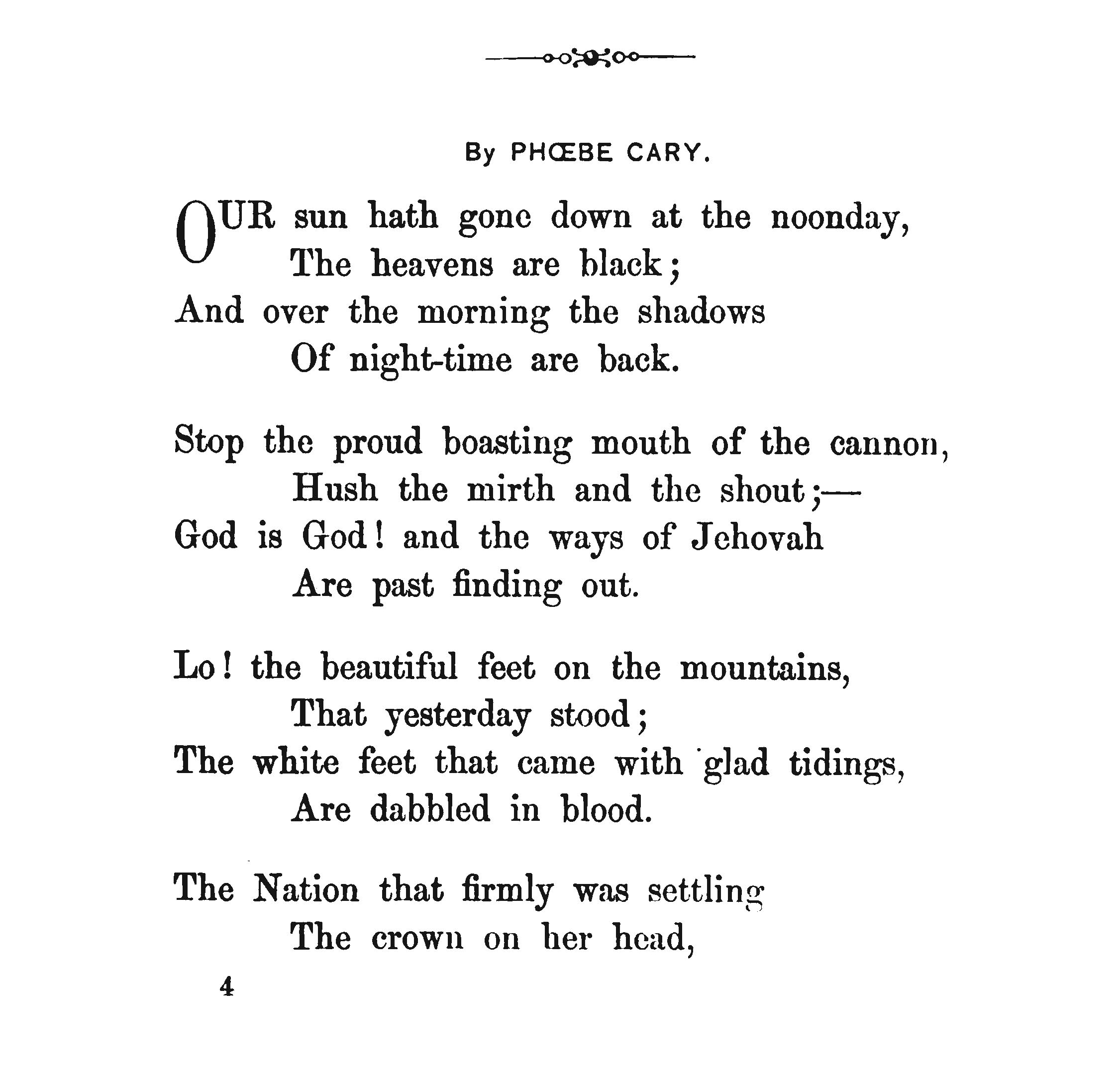
-
Description
Philadelphia publishing house J.B. Lippincott & Co. compiled poetical tributes to President Lincoln in the months after his assassination. This piece, by Phoebe Cary, talks about how the mood of the country has changed from happiness for the end of the war to sadness for Lincoln's death. She goes on to describe his mercy and considerate leadership. Phoebe Cary was a well known poet and suffragette from Ohio. Later in life she moved to New York with her sister, Alice Cary, who was also a poet. During her lifetime she published two volumes of her own work.
-
Source
University of Wisconsin - Madison, Digitized by Google
-
Rights
This item is in the public domain and may be reproduced and used for any purpose, including research, teaching, private study, publication, broadcast or commercial use, with proper citation and attribution.
-
Creator
Pheobe Cary
-
Publisher
J.B. Lippincott & Co.
-
Date
July 1, 1865
from Apr. 17, 1867
Monument to Lincoln
-
Full Title
A Monument to Mr. Lincoln
-
Description
This article from the San Antonio Express, published in April of 1867, describes a monument to Abraham Lincoln on display at the Union League Club House. The monument depicts Lincoln with arms outstretched toward a black man rising from a kneeling position to his feet. The sculpture is said to have been created by Mr. Ball, from Boston.
-
Source
infoweb.newsbank.com
-
Rights
N/A
-
Tags
-
Cite this Item
San Antonio Express. "A Monument to Mr. Lincoln". San Antonio Express. Remembering Lincoln. Web. Accessed December 13, 2025. https://rememberinglincoln.fords.org/node/1101
from Apr. 17, 1867
A Monument to Mr. Lincoln

-
Description
This article from the San Antonio Express, published in April of 1867, describes a monument to Abraham Lincoln on display at the Union League Club House. The monument depicts Lincoln with arms outstretched toward a black man rising from a kneeling position to his feet. The sculpture is said to have been created by Mr. Ball, from Boston.
-
Source
infoweb.newsbank.com
-
Rights
N/A
-
Creator
San Antonio Express
-
Publisher
San Antonio Express
-
Date
April 17, 1867
-
Material
newspaper
